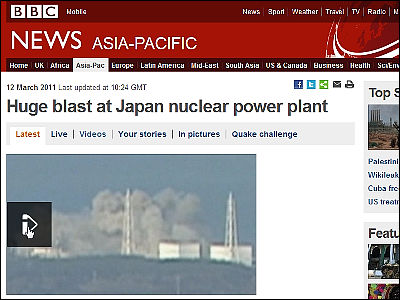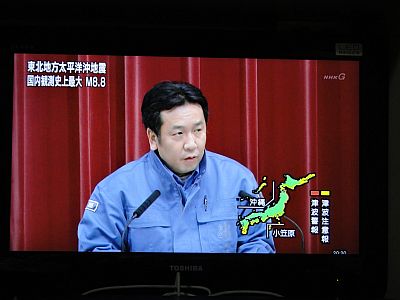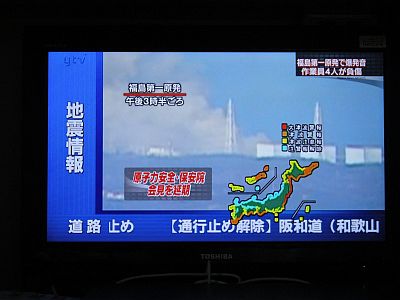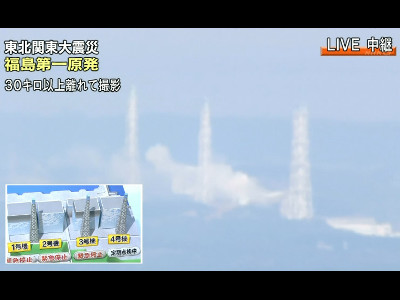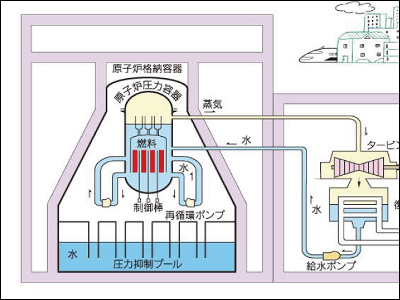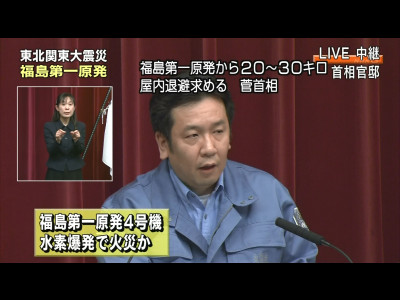Possibility that nuclear fuel of Fukushima Daiichi nuclear power plant 1 melted
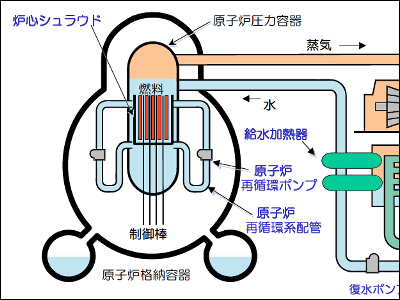
NHKAccording to a preliminary report of Nagasaki Nagasaki, it is likely that Nagasaki announced the possibility that the Fukushima Daiichi nuclear power plant Unit 1 melted out.
"The core meltdown is the worst case in the assumed nuclear accident. As this progresses, it may cause explosive reactions and spread the radiation widely to the outsideThat thing (Core meltingWhat is "meltdown").
Details are as below.
March 12th at 14:21: Fukushima Daiichi Nuclear Fuel Melted Out? NHK News
http://www3.nhk.or.jp/news/html/20110312/t10014623511000.html
According to the Nuclear and Industrial Safety Agency of Japan's Ministry of Economy, Trade and Industry, the radioactive substance "cesium" generated by nuclear fission of uranium fuel in the vicinity of Unit 1 in the site of the Fukushima Daiichi Nuclear Power Station was detected, Announced that it sees that a part of the nuclear fuel in the core melts away. NISA said that there was a possibility that a metal tube called a "cladding tube" filled with nuclear fuel rod uranium fuel melted. About this, Professor Naoto Sekimura of the University of Tokyo said, "It seems that a small part of the fuel melted and leaked out, but the nuclear reactor has already stopped and it is being cooled. I'd like the calm response to the residents as they are put in the nuclear reactor. "
This is the diagram inside the furnace by Tokyo Electric Power Company (PDF file)is.
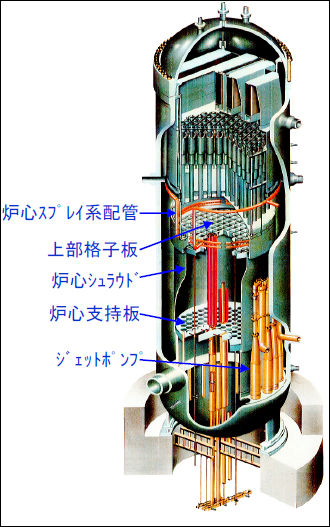
2011/03/12 14:41
Although most of the nuclear fuel is contained in it,Fuel clad pipeIt seems that it was broken.
Cooling water level of nuclear power plant, further possibility of decline MBS news - MBS news broadcast news video site -
According to the announcement, at 11:20 am, there is an indication that the fuel rod is exposed up to about 90 cm from the surface of the water.
It is unclear to what extent the fuel rods are actually exposed, and if the condition as displayed continues, there is a danger that a part of the fuel will start to melt, so we have brought 21,000 liters of water to the fire engine It is injecting into the reactor and continuing work to lower the core temperature.
Tokyo Newspaper: Fukushima nuclear serious crisis Radioactive confinement failure: Society (TOKYO Web)
Earthquake: 1000 times more radiation dose fuel rod damage at Fukushima nuclear plant - every day jp (Mainichi Newspaper)March 12, 2011 at 10:42 (last update March 12 th 13:35)
Fukushima No. 1, No. 2 No. 1 was the first nuclear power plant in Tokyo Electric Power Company, and in March 1971 Unit 1 began commercial operation. Currently, six nuclear reactors are in operation. The second is about 12 kilometers south of the first, and in November 1982, Unit 1 began commercial operations. A total of four units are in operation. Both of these are "boiling water nuclear reactors" that boil water by the heat generated by the fuel fission reaction and generate turbines by turning the turbine with the resultant steam, total power generation of 10 units total is about 9.1 million kilowatts.
2011/03/12 14:48
Asahi.com (Asahi Shimbun): Fukushima Daiichi nuclear power plant Unit 1, melting start or fear of explosive reaction - Society
The core meltdown is the worst case in the assumed nuclear accident. As this progresses, it may cause explosive reactions and spread the radiation to the outside widely.
Core melting (melting roasting), meltdown (meltdown) is the melting and breakage of nuclear reactors at nuclear power plants etc. due to high heat above the heat resistance limit. Among the assumed accidents, the worst situation is that accidents involving the destruction of nuclear reactors can not keep the soundness of the core under the safety standards set at the time of reactor design.
Current affairs dot com: Fukushima Dai 1 nuclear reactor core melt = near cesium detection = NISA
Emergency situation of Fukushima Daiichi Nuclear Power Plant, Risky Dangerous Water Area: Science: YOMIURI ONLINE (Yomiuri Shimbun)
Under such circumstances, the reactor core may be overheated. This may be considered as a cause of pressure rise. When the pressure abnormally increases, it becomes impossible to operate the emergency core cooling device (ECCS) which injects emergency cooling water into the nuclear reactor, and control becomes more and more difficult. It is not serious if water vapor containing a trace amount of radioactive substance is released to the outside, but if the fuel rod is damaged and exposed and it reacts with water vapor and it explodes, then a large amount of radioactive substances will be emitted to the outside It will be released. There is also the possibility of becoming the worst case as the 1979 Three Mile Island nuclear power plant accident.
At the Nuclear and Industrial Safety Agency meeting on the afternoon of 13th, the company announced at the Tokyo Electric Power Fukushima No. 1 nuclear power plant in Fukushima Prefecture the first nuclear power plant No. 1 "the possibility of melting the core is high." We dispatched an expert team of radiation medical experts to the site and inspected it and confirmed the radioactive substance cesium contained in the fuel.
2011/03/12 15: 03
Asahi.com (Asahi Shimbun): Fukushima Daiichi nuclear fuel rod 1.5 m Exposure from fire fighting - society
Nuclear Safety and NISA requests water supply support to the SDF Fukushima nuclear power plant: Nihon Keizai Shimbun
2011/03/12 15: 12
Asahi.com (Asahi Shimbun): Fukushima Daiichi nuclear power plant Unit 1, radioactive material in the steam emission atmosphere - Society
Asahi.com (Asahi Shimbun): Fukushima Daiichi Nuclear Power Plant, the water level does not stop falling Self-Defense Force dispatch - Society
NISA sees that at the fuel part of Unit 1, not only the metallic "cladding tube" covering uranium fuel, but also the "pellet" with fuel compacted may be melting.
2011/03/12 15: 20
【Earthquake】 Government "It seems that core melting has begun"
Also, ANN is reporting that the core temperature has reached over 2200 degrees to over 2700 degrees.
2011/03/12 15: 34
Asahi.com (Asahi Shimbun): The possibility that the reactor core is not cooled Fukushima No. 1 nuclear power plant No. 1 - Society
The Nuclear and Industrial Safety Agency explained that there was a possibility that the reactor core which rose to 2700 to 2800 degrees was not cooled when the core melt occurred at Unit 1 of TEPCO Fukushima Daiichi Nuclear Power Plant on December 12. "It can be said that there is an accident similar to the Three Mile Island nuclear power plant accident in the United States (in 1979)."
Three Mile Island nuclear power plant accident - Wikipedia
The Three Mile Island Nuclear Power Plant Accident (Three Mile Agriculture Hatsuton Shogiko), a major nuclear power that occurred at the Three Mile Island Nuclear Power Station in Pennsylvania in the northeast of the United States of America on March 28, 1979 accident. It is a severe accident that is classified as a nuclear reactor coolant accident (Loss Of Coolant Accident, LOCA) and exceeds the scale of the assumed accident. Also known as "TMI (Three Mile Island) Accident".
2011/03/12 15: 40
Fukushima Daiichi Nuclear Power "Possibility of advanced core melting" NISA: Nihon Keizai Shimbun
The Nuclear and Industrial Safety Agency of Nuclear and Industrial Safety Agency (NISA) announced at 2 pm on December 12 that TEPCO's Fukushima Daiichi nuclear power plant Unit 1 will be damaged at the heart of the nuclear reactor "core melting may be advanced." Cesium and iodine associated with fuel nuclear fission were detected from the area surrounding the power plant. It is thought that the fuel melted and leaked out. If core melting is the case, the worst nuclear disaster has occurred. It was the first time that the phenomenon of core melting was confirmed in Japan.
2011/03/12 15: 59
"TEPCO: Fukushima Daiichi Nuclear Power Plant | Summary of Power PlantAccording to the report, Unit 1, which has the possibility of meltdown this time, was started in 1967, started commercial operation in 1971, made by GE.Chernobyl nuclear power plantIt was started in 1971, and since January 1978 the first reactor has started commercial operation, which means that this Fukushima Daiichi Nuclear Power Station is older.
Also, the number of fuel assemblies was 400, the number of control rods was 97, the total length of the fuel assembly was about 4 meters 35 centimeters, which means that 1 meter 70 centimeters was exposed, so It is understood that it was about 1.
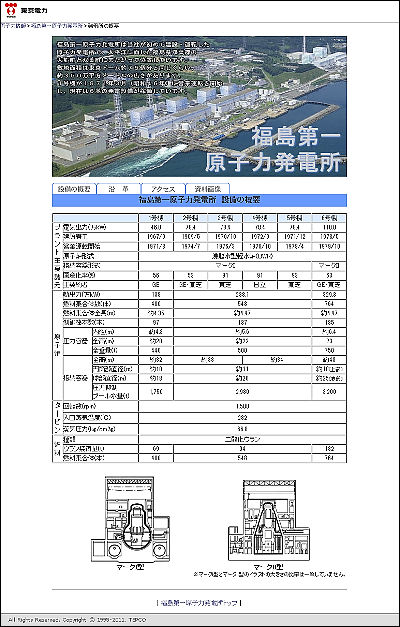
The total height of the containment vessel is 32 meters, the diameter of the cylindrical part is about 10 meters, the diameter of the ball part is about 18 meters, the pressure suppression pool water volume is 1750 tons, the fuel uranium loading quantity is 69 tons , The following is the container type 1 mark type.
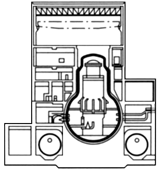
2011/03/12 16: 01
Confirmation of steam discharge and decompression of Fukushima Daiichi nuclear containment container: Nihon Keizai Shimbun
Asahi.com (Asahi Shimbun): Fukushima Daiichi Nuclear Power Plant opened, pressure drop in core - Society
However, as a result of opening the valve, cesium of radioactive material leaked to the outside, the concentration of radiation in the surroundings increased.
2011/03/12 16: 21
Earthquake: Occurred at Fukushima nuclear plant "core melting" "Cesium 137" - Everyday jp (Mainichi Shimbun)
2011/03/12 16: 48
Influence on Tohoku Region Pacific Offshore Earthquake on our facilities 【As of 3 pm】
※ The reactor was stopped at Unit 1 and the reactor steam was cooled with an emergency condenser,
Currently it is stopped. Because the pressure inside the reactor containment is rising,
In order to ensure safe and safe operation, according to the instructions in the table below, the pressure in the reactor containment vessel of Unit 1 is lowered
We have taken measures to make it succeed at around 14:30.
At present, the water level of the nuclear reactor is getting low, we are injecting water sequentially.
Furthermore, the following points should be noted in the above release.
※ In addition, we are carrying out the operation to lower the pressure of the reactor containment vessel of Unit 1,
The dose of one employee who worked in the reactor building exceeded 100 mSv.
(106.3 mSv), but I was diagnosed by a specialist at the off-site center.
What does this mean? "(PDF file)Main points of revision of related laws related to Radiation Hazards Prevention LawAccording to "1. Dose limit for occupational exposure", the effective dose limit is "50 mSv per year" and "100 mSv per 5 years", which indicates that we carried out considerably dangerous work.
· Continued
Explosive sound at Fukushima Daiichi nuclear power plant 1 - GIGAZINE
Related Posts:
in Note, Posted by darkhorse
